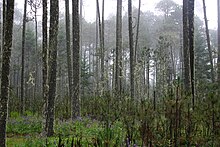Madrean Pine-Oak Woodlands

The Madrean Pine-Oak Woodlands are subtropical forest areas in the mountains of Mexico and the southwestern United States . They are the predominant type of vegetation in the high altitudes of all Mexican mountain ranges. There are other deposits in Arizona , New Mexico and Texas . The Madrean Pine-Oak Woodlands are listed by Conservation International as one of the most threatened biodiversity hotspots . The name comes from the Spanish name Sierra Madre (mountains of the mother) for all larger mountain ranges in Mexico.
Ecosystem
The Madrean pine and oak forests are largely composed of pine and oak . Other tree species are fir and Douglas fir . The forests are home to 44 of the world's 110 species of pine and, with over 135 species of oak, more than 30% of the world's species. The rest of the flora has not even come close to being recorded, it is estimated at over 5300 species, of which 70% are likely to be endemic . The character of the forests ranges from loose trees dominated by oaks in a savannah-like landscape to dense pine forests with a crown. In particular, the loose forests are particularly adapted to the environmental factor of fire ; they depend on sporadic forest fires of natural origin to keep the landscape open and prevent encroachment.
The fauna of the forests is diverse. It is made up of a large variety of around 200 amphibians and around 380 reptiles . Over 520 species of birds have been identified and more than 330 mammals . Around 80 species of fish were also detected. The number of invertebrates cannot even be estimated.
Spread and threat
The original extent of the Madrean Pine-Oak Woodlands is determined to be over 450,000 km², of which around 92,000 km² are still preserved at the beginning of the 21st century. The greatest threat is direct deforestation by forestry . Further factors are the sprawl of the hilly countries in the vicinity of metropolises and the suppression of forest fires. If there are no fires through the ecosystem for decades, the semi-open forests are transformed into dense stands in which the conifers dominate. This effect occurred particularly in the United States thanks to the extensive suppression of forest fires between the 1930s and 1980s / 1990s. The significance of forest fires for many adapted ecosystems has only been recognized since the end of the 20th century. On the other hand, intensive burning of the vegetation for the purpose of soil fertilization for cattle rearing destroys the ecosystem immediately and sustainably. Other human influences are the intensive picking of mushrooms as delicacies and the removal of tillandsia as houseplant and as Christmas decorations popular in the region.
Web links
- Conservation International: Madrean Pine-Oak Woodlands (English)
Individual evidence
- ↑ Unless otherwise stated, this chapter is based on: Conservation International: Madrean Pine-Oak Woodlands - Biodiversity ( Memento of the original dated August 12, 2010 in the Internet Archive ) Info: The archive link was inserted automatically and has not yet been checked. Please check the original and archive link according to the instructions and then remove this notice. (accessed on August 19, 2010)
- ↑ Unless otherwise stated, this chapter is based on: Conservation International: Madrean Pine-Oak Woodlands - Human Impacts ( Memento of the original from August 17, 2010 in the Internet Archive ) Info: The archive link was automatically inserted and not yet checked. Please check the original and archive link according to the instructions and then remove this notice. (accessed on August 19, 2010)


